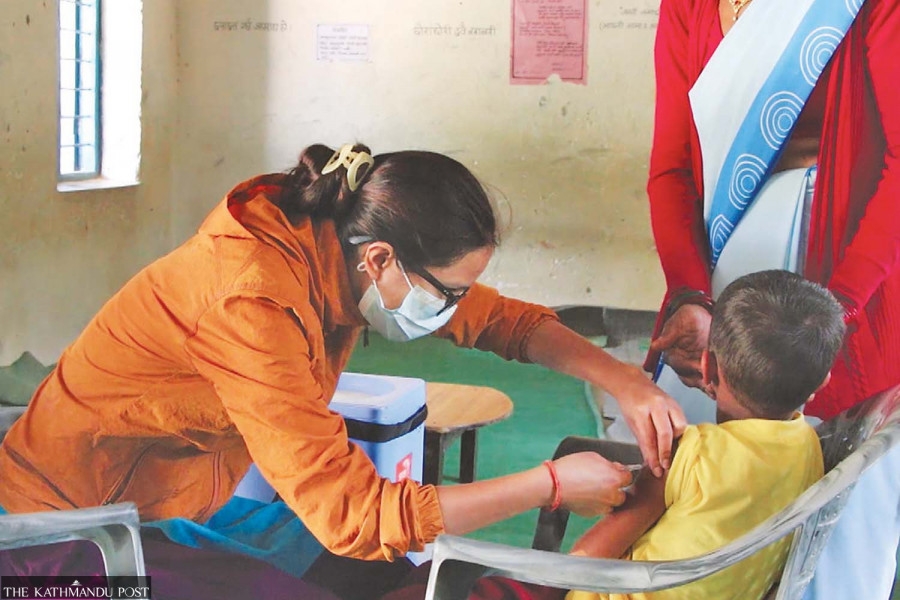Health
Infants aged less than nine months to be jabbed against measles
Nepal is committed to eliminating the disease by 2026.
Arjun Poudel
Infants less than nine months old in nine districts considered at high risk of measles are set to be inoculated with the first dose of the vaccine against the disease. Health agencies in those districts have started preparations for a vaccination campaign, officials said.
The move by the Ministry of Health and Population comes amid reports of infection of the deadly virus in infants less than nine months old.
“We have decided to inoculate within a month all children aged between 6 months to 15 years in the nine high-risk districts with the measles vaccine,” said Dr Abhiyan Gautam, chief of the Immunisation Section at the Family Welfare Division of the Department of Health Services. “In a recent outbreak of measles in several districts, many infants less than nine months old were also infected.”
Health authorities across the country provide two doses of the Measles-Rubella vaccine to children aged between nine and 15 months. The health ministry recently launched a nationwide door-to-door campaign to “search and inoculate” children who have missed out on routine immunisation.
The government provides 13 types of vaccines under the national immunisation programme, including the measles vaccine. Apart from this, the ministry carries out a Measles-Rubella campaign every four years, vaccinating 9–15-month-olds.
Measles is a contagious disease transmitted through fluids from the nose, mouth or throat of infected persons and through air. The virus infects the respiratory tract and then spreads throughout the body. It remains a big cause of death among young children globally despite the availability of a safe and effective vaccine, according to the World Health Organisation.
Nepal is committed to eliminating measles by 2026, a deadline which was extended to 2023 from 2019 earlier. To declare a country as measles-free, the number of cases should be less than five per one million people throughout the year.
However, this year, the country witnessed a massive measles outbreak. At least one child died and 947 children from 15 districts tested positive for the measles virus. Of the total 947 positive cases, 97 infants (10.25 percent) were under nine months of age.
“A recent massive outbreak of the measles virus and infection of children less than nine months of age show that protection coming only from breastmilk is not sufficient for infants of high-risk areas to be immune to measles infection,” said Gautam. “So, we have decided to administer the vaccine doses to six-month-olds.”
Although there are concerns over the efficacy of early vaccination, officials at the health ministry believe that the administration of the first dose of the vaccine before nine months of age in high-risk areas will lessen measles-related mortality and morbidity rates. They also said the children will again be inoculated upon reaching nine months and 15 months. Those children will also get additional doses during the campaign, which the health authorities start every four months or in the aftermath of major outbreaks of the virus.
“Decision to administer the measles vaccine to children above six months might have been taken to prevent infection in infants prior to vaccination,” said Dr Shyam Raj Upreti, an immunisation expert. “The authorities might have taken the decision to prevent mortality and morbidity due to infections in high-risk areas. It is just a temporary measure to lessen loss from infection.”
Over 1.5 million children aged between six months and 15 years from nine districts—Bajura, Kanchanpur, Kailali, Surkhet, Bardiya, Dang, Mahottari, Morang, and Sunsari will be administered the vaccine during the month-long drive. These districts witnessed massive measles outbreaks in January and February of this year.
A recent report of the Nepal Demographic and Health Survey-2022 carried out by the Ministry of Health and Population shows that four percent of the children in the 12-23 months age group have received no vaccination. The vaccine dropout rate is 16 percent, meaning that 20 percent of the children have either not taken any dose of routine vaccine or not completed all doses.
This figure was just one percent in 2016, and the rapid surge in the number of unvaccinated children poses a serious threat to the country’s achievements in immunisation made over the years through huge investments, child health experts have warned.
Low vaccination coverage, floating population, lack of public awareness on the importance of vaccines and apathy of the authorities to plug the loopholes are considered to be some of the reasons behind the regular outbreaks of measles in different parts of the country.
Early symptoms, which usually appear 10–12 days after infection, include high fever, runny nose, bloodshot eyes and white tiny spots inside the mouth. Several days later, rashes develop on the face, upper neck and other body parts.
Some people may suffer from severe complications, such as pneumonia and encephalitis, and these diseases may also lead to death.
Measles was endemic in Nepal and an average of 90,000 cases were recorded every year from 1994 to 2004. Routine measles vaccination began in 1979, starting with three districts. The campaign was extended nationwide after 10 years. Still, measles continues to stalk children across the country.




 20.12°C Kathmandu
20.12°C Kathmandu














